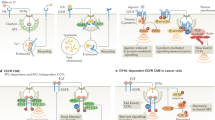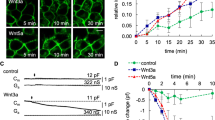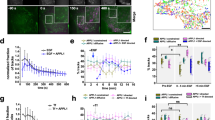Abstract
Endocytosis has long been thought of as simply a way for cells to internalize nutrients and membrane-associated molecules. But an explosive growth in knowledge has given a new dimension to our understanding of this process. It now seems that endocytosis is a master organizer of signalling circuits, with one of its main roles being the resolution of signals in space and time. Many of the functions of endocytosis that are emerging from recent research cannot yet be reconciled with the canonical view of intracellular trafficking but, instead, point to endocytosis being integrated at a deeper level in the cellular 'master plan' (the cellular network of signalling circuits that lie at the base of the cell's make-up). Deconvolution of this level, which we call the 'endocytic matrix', might uncover a fundamental aspect of how a cell is built.
This is a preview of subscription content, access via your institution
Access options
Subscribe to this journal
Receive 51 print issues and online access
$199.00 per year
only $3.90 per issue
Buy this article
- Purchase on Springer Link
- Instant access to full article PDF
Prices may be subject to local taxes which are calculated during checkout





Similar content being viewed by others
References
Doherty, G. J. & McMahon, H. T. Mechanisms of endocytosis. Annu. Rev. Biochem. 78, 857–902 (2009).
Mayor, S. & Pagano, R. E. Pathways of clathrin-independent endocytosis. Nature Rev. Mol. Cell Biol. 8, 603–612 (2007).
Sorkin, A. & von Zastrow, M. Endocytosis and signalling: intertwining molecular networks. Nature Rev. Mol. Cell Biol. 10, 609–622 (2009).
Lanzetti, L. & Di Fiore, P. P. Endocytosis and cancer: an 'insider' network with dangerous liaisons. Traffic 9, 2011–2021 (2008).
Mills, I. G. The interplay between clathrin-coated vesicles and cell signalling. Semin. Cell Dev. Biol. 18, 459–470 (2007).
Fortini, M. E. Notch signaling: the core pathway and its posttranslational regulation. Dev. Cell 16, 633–647 (2009).
Di Guglielmo, G. M., Le Roy, C., Goodfellow, A. F. & Wrana, J. L. Distinct endocytic pathways regulate TGF-β receptor signalling and turnover. Nature Cell Biol. 5, 410–421 (2003).
Sigismund, S. et al. Clathrin-mediated internalization is essential for sustained EGFR signaling but dispensable for degradation. Dev. Cell 15, 209–219 (2008).
Yamamoto, H., Sakane, H., Michiue, T. & Kikuchi, A. Wnt3a and Dkk1 regulate distinct internalization pathways of LRP6 to tune the activation of β-catenin signaling. Dev. Cell 15, 37–48 (2008).
Fehrenbacher, N., Bar-Sagi, D. & Philips, M. Ras/MAPK signaling from endomembranes. Mol. Oncol. 3, 297–307 (2009).
Pawson, T. Dynamic control of signaling by modular adaptor proteins. Curr. Opin. Cell Biol. 19, 112–116 (2007).
Tsukazaki, T., Chiang, T. A., Davison, A. F., Attisano, L. & Wrana, J. L. SARA, a FYVE domain protein that recruits Smad2 to the TGFβ receptor. Cell 95, 779–791 (1998).
Hayes, S., Chawla, A. & Corvera, S. TGFβ receptor internalization into EEA1-enriched early endosomes: role in signaling to Smad2. J. Cell Biol. 158, 1239–1249 (2002).
Chen, Y. G., Wang, Z., Ma, J., Zhang, L. & Lu, Z. Endofin, a FYVE domain protein, interacts with Smad4 and facilitates transforming growth factor-β signaling. J. Biol. Chem. 282, 9688–9695 (2007).
Miaczynska, M. et al. APPL proteins link Rab5 to nuclear signal transduction via an endosomal compartment. Cell 116, 445–456 (2004).
Schenck, A. et al. The endosomal protein Appl1 mediates Akt substrate specificity and cell survival in vertebrate development. Cell 133, 486–497 (2008). In zebrafish, Appl1 was shown to spatially restrict the activity of the signalling receptor Akt in endosomes, resulting in Akt substrates being biased towards Gsk3β and increased cell survival during animal development.
Zoncu, R. et al. A phosphoinositide switch controls the maturation and signaling properties of APPL endosomes. Cell 136, 1110–1121 (2009). Signalling through EGFR is controlled by the diversity and plasticity of the early endosome, which undergoes discrete maturation steps through a phosphoinositide switch from an early APPL endosome (where the induction of mitosis by EGFR is enhanced) to an endosome rich in PtdIns(3)P and EEA1.
Birtwistle, M. R. & Kholodenko, B. N. Endocytosis and signalling: a meeting with mathematics. Mol. Oncol. 3, 308–320 (2009).
Kholodenko, B. N. Four-dimensional organization of protein kinase signaling cascades: the roles of diffusion, endocytosis and molecular motors. J. Exp. Biol. 206, 2073–2082 (2003).
Maeder, C. I. et al. Spatial regulation of Fus3 MAP kinase activity through a reaction-diffusion mechanism in yeast pheromone signalling. Nature Cell Biol. 9, 1319–1326 (2007).
Perlson, E. et al. Vimentin-dependent spatial translocation of an activated MAP kinase in injured nerve. Neuron 45, 715–726 (2005).
Markevich, N. I., Tsyganov, M. A., Hoek, J. B. & Kholodenko, B. N. Long-range signaling by phosphoprotein waves arising from bistability in protein kinase cascades. Mol. Syst. Biol. 2, 61 (2006).
Disanza, A., Frittoli, E., Palamidessi, A. & Scita, G. Endocytosis and spatial restriction of cell signaling. Mol. Oncol. 3, 280–296 (2009).
Traynor, D. & Kay, R. R. Possible roles of the endocytic cycle in cell motility. J. Cell Sci. 120, 2318–2327 (2007).
Bryant, D. M. & Mostov, K. E. From cells to organs: building polarized tissue. Nature Rev. Mol. Cell Biol. 9, 887–901 (2008).
Altschuler, S. J., Angenent, S. B., Wang, Y. & Wu, L. F. On the spontaneous emergence of cell polarity. Nature 454, 88–889 (2008).
Jekely, G., Sung, H. H., Luque, C. M. & Rorth, P. Regulators of endocytosis maintain localized receptor tyrosine kinase signaling in guided migration. Dev. Cell 9, 197–207 (2005).
Palamidessi, A. et al. Endocytic trafficking of Rac is required for its activation and for the spatial restriction of signaling in cell migration. Cell 134, 135–147 (2008).
Caswell, P. T. et al. Rab25 associates with α5β1 integrin to promote invasive migration in 3D microenvironments. Dev. Cell 13, 496–510 (2007). RAB25 binds to the promigratory and invasive molecule α 5 β 1 -integrin, promoting rapid, spatially restricted recycling of the integrin, ultimately resulting in increased cellular migration and invasion in three-dimensional matrices.
del Pozo, M. A. et al. Integrins regulate Rac targeting by internalization of membrane domains. Science 303, 839–842 (2004).
del Pozo, M. A. et al. Phospho-caveolin-1 mediates integrin-regulated membrane domain internalization. Nature Cell Biol. 7, 901–908 (2005).
Balasubramanian, N., Scott, D. W., Castle, J. D., Casanova, J. E. & Schwartz, M. A. Arf6 and microtubules in adhesion-dependent trafficking of lipid rafts. Nature Cell Biol. 9, 1381–1391 (2007).
Royle, S. J., Bright, N. A. & Lagnado, L. Clathrin is required for the function of the mitotic spindle. Nature 434, 1152–1157 (2005).
Thompson, H. M., Cao, H., Chen, J., Euteneuer, U. & McNiven, M. A. Dynamin 2 binds γ-tubulin and participates in centrosome cohesion. Nature Cell Biol. 6, 335–342 (2004).
Lehtonen, S. et al. The endocytic adaptor protein ARH associates with motor and centrosomal proteins and is involved in centrosome assembly and cytokinesis. Mol. Biol. Cell 19, 2949–2961 (2008).
Miserey-Lenkei, S. et al. A role for the Rab6A' GTPase in the inactivation of the Mad2-spindle checkpoint. EMBO J. 25, 278–289 (2006).
Boucrot, E. & Kirchhausen, T. Endosomal recycling controls plasma membrane area during mitosis. Proc. Natl Acad. Sci. USA 104, 7939–7944 (2007).
Meyers, J., Craig, J. & Odde, D. J. Potential for control of signaling pathways via cell size and shape. Curr. Biol. 16, 1685–1693 (2006).
Schweitzer, J. K., Burke, E. E., Goodson, H. V. & D' Souza-Schorey, C. Endocytosis resumes during late mitosis and is required for cytokinesis. J. Biol. Chem. 280, 41628–41635 (2005).
Baluska, F., Menzel, D. & Barlow, P. W. Cytokinesis in plant and animal cells: endosomes 'shut the door'. Dev. Biol. 294, 1–10 (2006).
Furthauer, M. & Gonzalez-Gaitan, M. Endocytosis, asymmetric cell division, stem cells and cancer: unus pro omnibus, omnes pro uno. Mol. Oncol. 3, 339–353 (2009).
Santolini, E. et al. Numb is an endocytic protein. J. Cell Biol. 151, 1345–1352 (2000).
Berdnik, D., Torok, T., Gonzalez-Gaitan, M. & Knoblich, J. A. The endocytic protein α-Adaptin is required for Numb-mediated asymmetric cell division in Drosophila. Dev. Cell 3, 221–231 (2002).
Hutterer, A. & Knoblich, J. A. Numb and α-Adaptin regulate Sanpodo endocytosis to specify cell fate in Drosophila external sensory organs. EMBO Rep. 6, 836–842 (2005).
Emery, G. et al. Asymmetric Rab11 endosomes regulate Delta recycling and specify cell fate in the Drosophila nervous system. Cell 122, 763–773 (2005).
Nilsson, L. et al. Caenorhabditis elegans num-1 negatively regulates endocytic recycling. Genetics 179, 375–387 (2008).
McGill, M. A., Dho, S. E., Weinmaster, G. & McGlade, C. J. Numb regulates post-endocytic trafficking and degradation of Notch1. J. Biol. Chem. 284, 26427–26438 (2009).
Andrews, R. & Ahringer, J. Asymmetry of early endosome distribution in C. elegans embryos. PLoS ONE 2, e493 (2007).
Beckmann, J., Scheitza, S., Wernet, P., Fischer, J. C. & Giebel, B. Asymmetric cell division within the human hematopoietic stem and progenitor cell compartment: identification of asymmetrically segregating proteins. Blood 109, 5494–5501 (2007).
Coumailleau, F., Furthauer, M., Knoblich, J. A. & Gonzalez-Gaitan, M. Directional Delta and Notch trafficking in Sara endosomes during asymmetric cell division. Nature 458, 1051–1055 (2009). During the asymmetrical division of fly sensory-organ-precursor cells, the asymmetrical partitioning of SARA endosomes containing Notch and its ligand Delta to the pIIa daughter cell limits Notch signalling in the pIIb cell, thereby maintaining the asymmetrical configuration of the pIIb–pIIa pair.
Gillette, J. M., Larochelle, A., Dunbar, C. E. & Lippincott-Schwartz, J. Intercellular transfer to signalling endosomes regulates an ex vivo bone marrow niche. Nature Cell Biol. 11, 303–311 (2009). A specialized membrane domain of haematopoietic progenitor cells is trans -endocytosed by osteoblasts and trafficked to SARA endosomes, where it triggers signalling that leads to attenuation of the SMAD2 and SMAD3 pathway and to expression of chemokines that promote the homing of haematopoietic progenitor cells.
Simons, M. & Raposo, G. Exosomes: vesicular carriers for intercellular communication. Curr. Opin. Cell Biol. 21, 575–581 (2009).
Valadi, H. et al. Exosome-mediated transfer of mRNAs and microRNAs is a novel mechanism of genetic exchange between cells. Nature Cell Biol. 9, 654–659 (2007). A new endocytic-based mechanism of intercellular communication was uncovered, in which mRNA and microRNA are transported by exosomes, which can be transferred between the mast cells of different species, regulating gene transcription and protein expression.
Irion, U. & St Johnston, D. bicoid RNA localization requires specific binding of an endosomal sorting complex. Nature 445, 554–558 (2007). Components of ESCRT-II are found to bind to, and control, the localization of bicoid mRNA, which encodes a homeodomain-containing transcription factor that organizes anterior development in the fly, to the anterior of the D. melanogaster egg.
Skog, J. et al. Glioblastoma microvesicles transport RNA and proteins that promote tumour growth and provide diagnostic biomarkers. Nature Cell Biol. 10, 1470–1476 (2008).
Colaluca, I. N. et al. NUMB controls p53 tumour suppressor activity. Nature 451, 76–80 (2008).
Cicalese, A. et al. The tumor suppressor p53 regulates polarity of self-renewing divisions in mammary stem cells. Cell 138, 1083–1095 (2009). An essential role for p53 in the regulation of cancer stem cells was uncovered in this study. In the Erbb2 -transgenic mouse model, decreased levels of p53 lead to breast cancer stem cells undergoing symmetrical divisions at a greater frequency, and pharmacological restoration of p53 levels in these animals results in increased asymmetrical division of breast cancer stem cells and a reduction in tumour growth.
Yu, X., Riley, T. & Levine, A. J. The regulation of the endosomal compartment by p53 the tumor suppressor gene. FEBS J. 276, 2201–2212 (2009).
Muller, P. A. J. et al. Mutant p53 drives invasion by promoting integrin recycling. Cell 139, 1327–1341 (2009). Gain-of-function mutants of p53 increase the endocytic recycling of α 5 β 1 -integrin and EGFR in cooperation with p63, promoting invasion and metastasis.
Pyrzynska, B., Pilecka, I. & Miaczynska, M. Endocytic proteins in the regulation of nuclear signaling, transcription and tumorigenesis. Mol. Oncol. 3, 321–338 (2009).
Stauffer, D. R., Howard, T. L., Nyun, T. & Hollenberg, S. M. CHMP1 is a novel nuclear matrix protein affecting chromatin structure and cell-cycle progression. J. Cell Sci. 114, 2383–2393 (2001).
Enari, M., Ohmori, K., Kitabayashi, I. & Taya, Y. Requirement of clathrin heavy chain for p53-mediated transcription. Genes Dev. 20, 1087–1099 (2006).
Ohmori, K. et al. Monomeric but not trimeric clathrin heavy chain regulates p53-mediated transcription. Oncogene 27, 2215–2227 (2008).
Xiao, K. et al. Functional specialization of β-arrestin interactions revealed by proteomic analysis. Proc. Natl Acad. Sci. USA 104, 12011–12016 (2007).
Isokane, M. et al. Plasma-membrane-anchored growth factor pro-amphiregulin binds A-type lamin and regulates global transcription. J. Cell Sci. 121, 3608–3618 (2008).
Hieda, M. et al. Membrane-anchored growth factor, HB-EGF, on the cell surface targeted to the inner nuclear membrane. J. Cell Biol. 180, 763–769 (2008).
Mills, I. G. et al. Huntingtin interacting protein 1 modulates the transcriptional activity of nuclear hormone receptors. J. Cell Biol. 170, 191–200 (2005).
Jekely, G. Origin of eukaryotic endomembranes: a critical evaluation of different model scenarios. Adv. Exp. Med. Biol. 607, 38–51 (2007).
Ohya, T. et al. Reconstitution of Rab- and SNARE-dependent membrane fusion by synthetic endosomes. Nature 459, 1091–1097 (2009).
Snijder, B. et al. Population context determines cell-to-cell variability in endocytosis and virus infection. Nature 461, 520–523 (2009).
Pelkmans, L. et al. Genome-wide analysis of human kinases in clathrin- and caveolae/raft-mediated endocytosis. Nature 436, 78–86 (2005).
Stenmark, H. Rab GTPases as coordinators of vesicle traffic. Nature Rev. Mol. Cell Biol. 10, 513–525 (2009).
Donaldson, J. G. Arfs, phosphoinositides and membrane traffic. Biochem. Soc. Trans. 33, 1276–1278 (2005).
Raiborg, C. & Stenmark, H. The ESCRT machinery in endosomal sorting of ubiquitylated membrane proteins. Nature 458, 445–452 (2009).
Zhao, C., Du, G., Skowronek, K., Frohman, M. A. & Bar-Sagi, D. Phospholipase D2-generated phosphatidic acid couples EGFR stimulation to Ras activation by Sos. Nature Cell Biol. 9, 706–712 (2007).
Nada, S. et al. The novel lipid raft adaptor p18 controls endosome dynamics by anchoring the MEK–ERK pathway to late endosomes. EMBO J. 28, 477–489 (2009).
DeWire, S. M., Ahn, S., Lefkowitz, R. J. & Shenoy, S. K. β-Arrestins and cell signaling. Annu. Rev. Physiol. 69, 483–510 (2007).
Pasternak, S. H. et al. Presenilin-1, nicastrin, amyloid precursor protein, and γ-secretase activity are co-localized in the lysosomal membrane. J. Biol. Chem. 278, 26687–26694 (2003).
Pei, Z. & Baker, N. E. Competition between Delta and the Abruptex domain of Notch. BMC Dev. Biol. 8, 4 (2008).
Vaccari, T., Lu, H., Kanwar, R., Fortini, M. E. & Bilder, D. Endosomal entry regulates Notch receptor activation in Drosophila melanogaster. J. Cell Biol. 180, 755–762 (2008).
Wilkin, M. et al. Drosophila HOPS and AP-3 complex genes are required for a Deltex-regulated activation of Notch in the endosomal trafficking pathway. Dev. Cell 15, 762–772 (2008).
Grande-Garcia, A. et al. Caveolin-1 regulates cell polarization and directional migration through Src kinase and Rho GTPases. J. Cell Biol. 177, 683–694 (2007).
Acknowledgements
We apologize to those colleagues whose primary research papers or important discoveries could not be properly acknowledged because of space constraints. We thank A. Sorkin and M. von Zastrow for sharing, ahead of publication, their excellent review on endocytosis and signalling. We also thank P. R. Romano for critically editing the manuscript. Work in the authors' laboratories is supported by grants from the following: the Italian Association for Cancer Research (AIRC) and the Italian Ministry of Education, University and Scientific Research (MIUR) (to G.S. and P.P.D.F.); the Association for International Cancer Research (G.S.); and the Italian Ministry of Health, the European Community, the European Research Council, the Cariplo Foundation, the Ferrari Foundation and the Monzino Foundation (P.P.D.F.).
Author information
Authors and Affiliations
Ethics declarations
Competing interests
The authors declare no competing financial interests.
Additional information
Reprints and permissions information is available at http://www.nature.com/reprints. Correspondence should be addressed to P.P.D.F. (pierpaolo.difiore@ifom-ieo-campus.it) or G.S. (giorgio.scita@ifom-ieo-campus.it).
Rights and permissions
About this article
Cite this article
Scita, G., Di Fiore, P. The endocytic matrix. Nature 463, 464–473 (2010). https://doi.org/10.1038/nature08910
Published:
Issue Date:
DOI: https://doi.org/10.1038/nature08910
This article is cited by
-
Deterministic early endosomal maturations emerge from a stochastic trigger-and-convert mechanism
Nature Communications (2023)
-
The Therapeutic Effects of Exosomes Derived from Human Umbilical Cord Mesenchymal Stem Cells on Scleroderma
Tissue Engineering and Regenerative Medicine (2022)
-
Endocytosis in the context-dependent regulation of individual and collective cell properties
Nature Reviews Molecular Cell Biology (2021)
-
PAC1 Receptor Internalization and Endosomal MEK/ERK Activation Is Essential for PACAP-Mediated Neuronal Excitability
Journal of Molecular Neuroscience (2021)
-
A case of immune complex mediated tubulointerstitial disease and nephrotic syndrome: anti LRP-2 Nephropathy with diffuse podocyte effacement
Journal of Nephrology (2021)
Comments
By submitting a comment you agree to abide by our Terms and Community Guidelines. If you find something abusive or that does not comply with our terms or guidelines please flag it as inappropriate.



